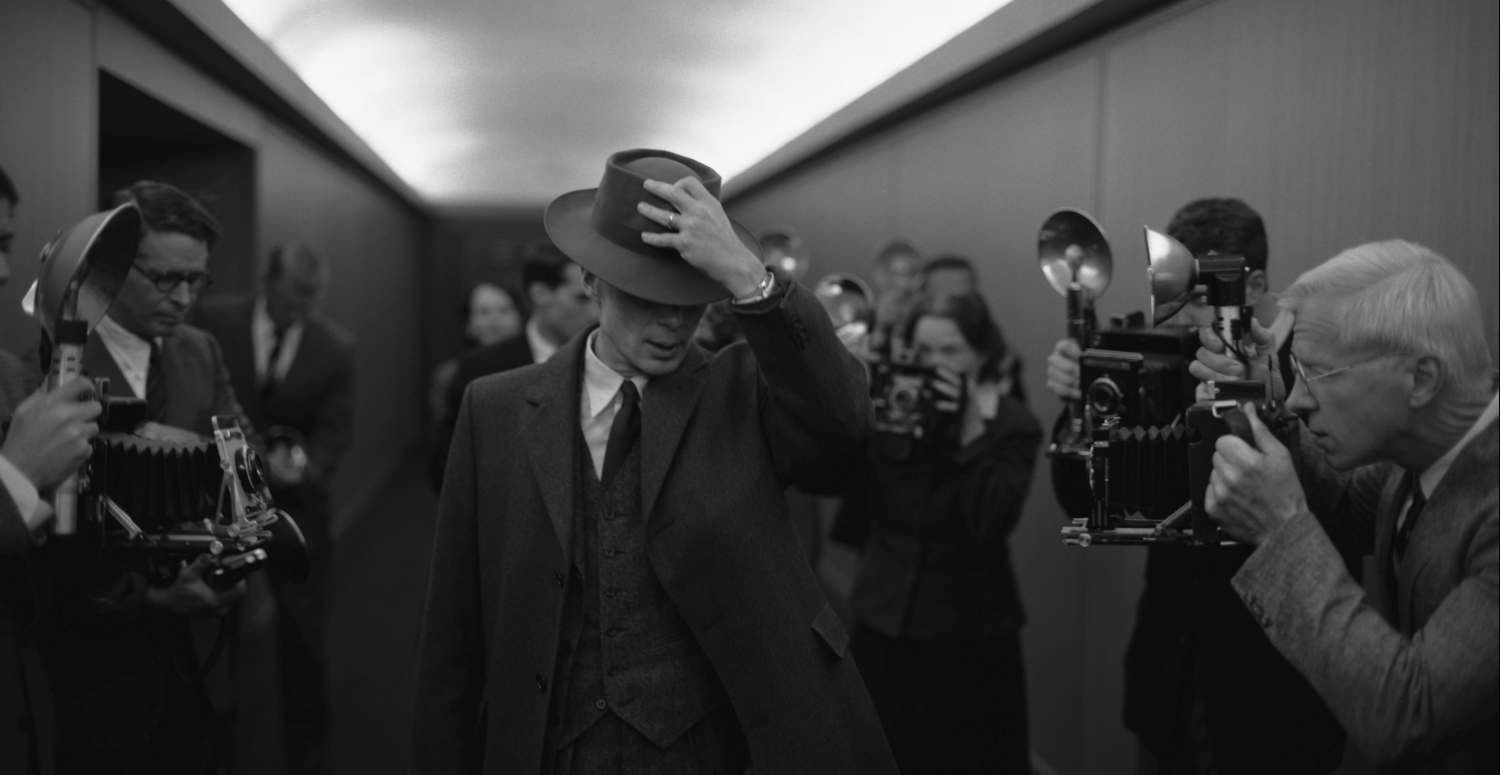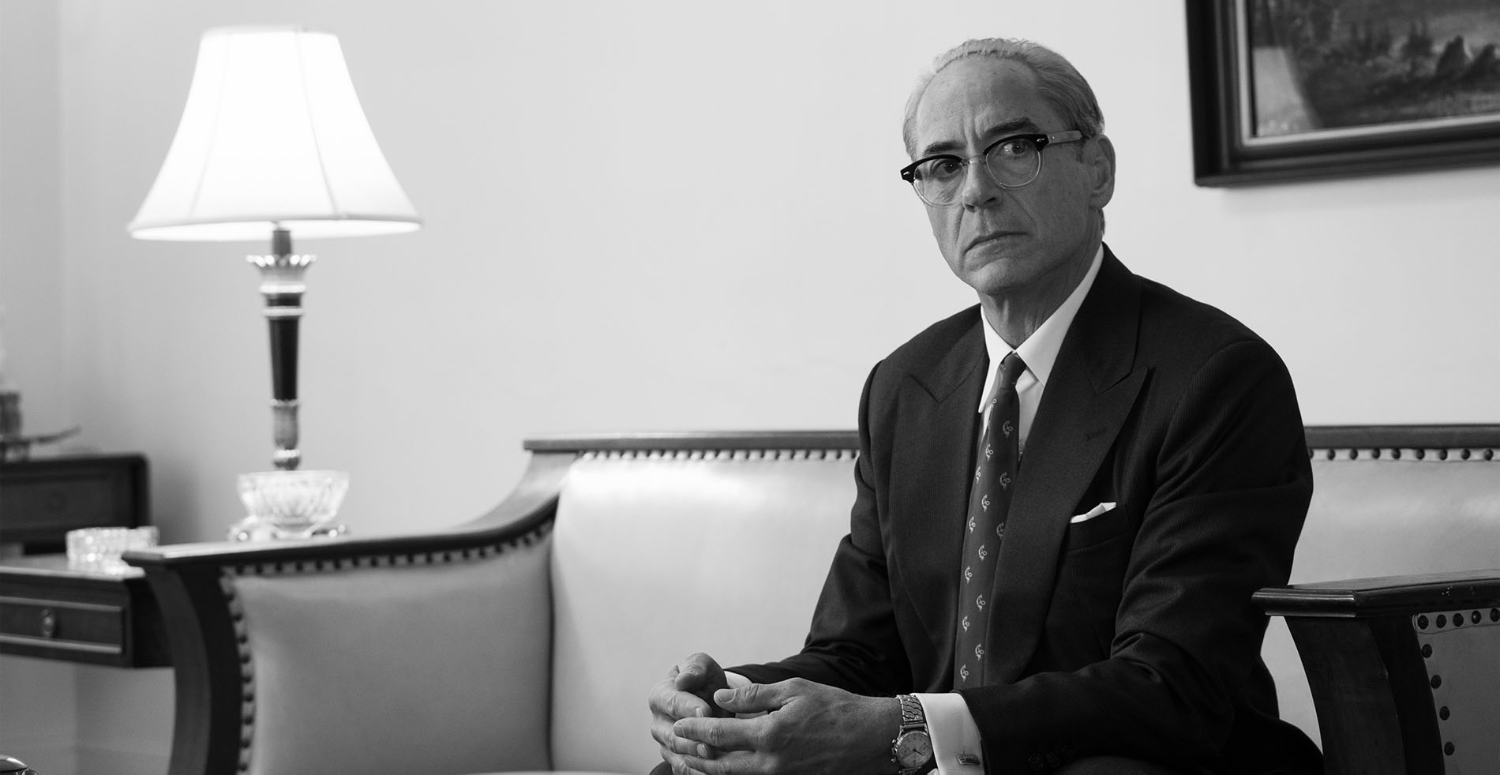Oppenheimer
Best Picture – Oscars
Best Director – Oscars
Best Actor & Supporting Actor – Oscars
Best Cinematography, Editing, Score – Oscars
Best Picture, Director, Actor, Supporting Actor, Cinematography, Editing, Score – BAFTA
Best Picture (Drama), Directing, Score, Actor & Supporting Actor (Drama) – Golden Globes
Outstanding Theatrical Motion Picture – DGA & PGA
Outstanding Cast, Actor, & Supporting Actor – SAG
2023

FR EN
Qu’il soit à rebours, figé, manquant, ralenti, condensé, transcendé ou inversé, s’il y a bien une notion présente dans tous les films de Christopher Nolan c’est celle du temps. Avec « Oppenheimer » le temps est cette fois fusionné avec une intrigue nous plongeant dans l’Histoire de l’Humanité à travers le bouleversement profond que devint la bombe atomique. Innovant à chaque projet, le cinéaste britannique s’attaque ici à un nouveau genre dans sa filmographie, le biopic, en adaptant le roman « American Prometheus : The Triumph of J. Robert Oppenheimer ». Le maître du blockbuster d’auteur réussit un biopic aussi subtil qu’incarné et transcende les codes du genre avec une œuvre à la fois portrait intime, film de procès, et thriller à suspense. C’est une œuvre qui respecte son public et participe au retour à des salles comblées par cet événement dit du ‘Barbenheimmer’. C’est tout simplement l’un des films les plus impressionnants de l’année !
« Oppenheimer » est une épopée viscérale. Le but est bien sûr de raconter l’histoire de la bombe mais aussi d’expérimenter le retentissement de cette création à travers le temps. Il confronte l’homme à une puissance qui le dépasse à l’image d’un poster aux antipodes du biopic classique où la création du protagoniste l’écrase de plusieurs mégatonnes. C’est une tragédie évoquant deux fissions, une atomique et une personnelle, qui donnent naissance à une création au service de la destruction. Une création qui fait en même temps avancer l’Humanité tout en lui donnant le moyen de s’éteindre. En cela, le film est une palpitante étude de personnage qui examine les dilemmes moraux et nous embarque dans un périple au cœur de l’ambition et de la culpabilité humaines. A travers l’histoire d’un homme, Nolan livre aussi un commentaire social, un pamphlet à charge contre les Etats-Unis et une réflexion sur la naissance d’une ère terrifiante. Après la crise écologique dans « Interstellar », et déjà la menace nucléaire dans « Tenet » – c’était en effet le même sujet mais dissimulé sous un thriller d’action conceptuel – « Oppenheimer » résonne encore plus avec notre présent et devient son film le plus politique.
Loin des prérequis du genre, comme « Dunkerque » l’était aussi, « Oppenheimer » est une expérience sensorielle. Elle nous plonge dans l’esprit du scientifique à travers ses souvenirs, ses hallucinations, son imagination ou ses traumas mis en images notamment dans une scène de sexe fantasmée, un bombardement cauchemardé ou dans des décors tremblants. A travers les efforts scientifiques pour concevoir l’arme ultime, Nolan décrit l’implosion de son créateur. Oppenheimer est le film. Tous les personnages secondaires ainsi que les spectateurs l’accompagnent ainsi dans son périple scientifique et moral. C’est dans cette optique que Nolan a écrit le scénario à la première personne tel une véritable immersion dans le personnage qu’incarne brillamment Cillian Murphy (Peaky Blinders). L’acteur irlandais habite son rôle et porte véritablement le film aux côtés d’un Robert Downey Jr. (Iron Man) réincarné et d’un Matt Damon (Jason Bourne) promu général.

Pour son premier film chez Universal – après avoir quitté Warner suite à leur politique désastreuse durant la pandémie – Nolan signe une œuvre ambitieuse tournée en IMAX 70mm et ayant nécessité de tout simplement inventer une pellicule IMAX en noir et blanc. Il s’oblige à tourner l’intégralité des scènes sans avoir recours aux effets spéciaux CGI, et relève le défi avec son chef-opérateur Hoyte von Hoytema de filmer l’intime avec la plus grosse caméra du monde scrutant avec intensité les visages de sa galerie de personnages. Le recours à une ribambelle de stars ne tombe pas dans le défilé de caméos mais au contraire permet de s’approprier rapidement le récit, d’assimiler plus facilement les nombreux personnages d’un scénario dense grâce à leurs visages connus : Oppenheimer connaît tous ces personnages, nous sommes dans sa tête, alors nous aussi, nous les reconnaissons immédiatement. Voilà, un cas où le casting démentiel est pour une fois justifié par l’histoire elle-même !
Si le film débute comme un biopic classique, il bascule rapidement avec une narration inventive oscillant constamment entre les perspectives (couleur/N&B) et les époques (20s-60s) tout en conservant une incroyable fluidité. Malgré une narration non-linéaire sans la moindre indication temporelle ou géographique, l’intrigue reste parfaitement claire reflétant l’immense travail de montage de Jennifer Lame. Moins conceptuel que certains de ses précédents, on y retrouve néanmoins la patte Nolan avec une dualité des points de vue l’un en couleur et l’autre en N&B. L’un étant totalement subjectif quand l’autre est plutôt objectif, l’un étant personnel quand l’autre est plutôt historique, l’un se concentrant sur Robert Oppenheimer quand l’autre suit Lewis Strauss en miroir. La couleur apporte la fusion quand le N&B provoque la fission d’un monde, celui d’Oppenheimer, mais aussi le nôtre par extension. Les différents éléments de l’intrigue se mêlent ainsi sans discontinuité jusqu’à pleinement s’ancrer dans notre présent et notre futur. Comme à son habitude Chris Nolan déjoue une nouvelle fois les attentes dans ce biopic consacré au père de la bombe atomique, aussi bien sur l’explosion elle-même que sur la conclusion. Sachant que la fin de l’histoire (voire de l’Histoire) est connue d’avance, il ne construit pas son suspense sur la réussite scientifique ou le bombardement mais plutôt sur une interrogation qui a germé chez le spectateur dès les premières scènes.
Si la maîtrise visuelle est assurée, le travail sur le son est également remarquable nous faisant frissonner devant un compte à rebours et nous bombardant de musiques tout du long pour ne rendre que plus détonants les rares silences. L’œuvre historique et introspective se permet même quelques clins d’œil aux spectateurs dans les dialogues sans sortir de la narration mais rappelant qu’il s’agit bien de cinéma et soulignant la postérité envisagée par les personnages. Le réalisateur et scénariste de « Inception », « Le Prestige » ou « The Dark Knight » se renouvelle donc avec un nouveau genre, autant que son compositeur Ludwig Göransson qui signe une bande-originale accompagnant parfaitement cette fresque captivante trois heures durant. Avec un dernier acte particulièrement haletant, et une fin hautement pertinente, « Oppenheimer » conclut en force et s’impose comme une œuvre de cinéma aussi riche que spectaculaire.
Whether backwards, stuck, running out, slowed down, compressed, transcended or inverted, if there’s one notion permeating all Christopher Nolan’s films, it’s time. With “Oppenheimer”, time is fused with a plot that takes us back into the history of mankind through the profound upheaval wrought by the atomic bomb. Innovating with every project, the British filmmaker here tackles a new genre in his filmography – the biopic – by adapting the novel “American Prometheus: The Triumph of J. Robert Oppenheimer”. The master of the auteur blockbuster achieves a biopic as subtle as it is embodied, overcoming the codes of the genre with a piece that is part inner portrait, part trial movie, part suspense thriller. It’s a movie that respects its audience, and helps to bring back sold-out cinemas for the ‘Barbenheimmer’ event. Quite simply, this is one of the most impressive films of the year!
“Oppenheimer” is a visceral epic. The aim is, of course, to tell the story behind the bomb, but also to experience the impact of this creation over time. It confronts man with a power that surpasses him, just like the poster, at odds with the conventional biopic, in which the protagonist’s creation dwarfs him by several megatons. It’s a tragedy depicting two fissions, one atomic and one personal, which give rise to a creation at the service of destruction. A creation that at the same time drives humanity forward and allows it to die out. In this regard, the film is a thrilling character study that examines moral dilemmas and takes us on a journey to the heart of human ambition and guilt. Through the story of one man, Nolan also delivers a social commentary, an indictment of the United States and a look at the birth of a terrifying era. After the ecological crisis in “Interstellar”, and the nuclear threat in “Tenet” – yes, it was the same theme, but concealed beneath a conceptual action thriller – “Oppenheimer” resonates even more with our present, and becomes his most political movie yet.
Far from the genre’s preconceptions, as “Dunkirk” was too, “Oppenheimer” is a sensory experience. It immerses us in the scientist’s mind, through his memories, hallucinations, imagination and traumas, as illustrated by a fantasized sex scene, a nightmarish bombardment and shivering sets. Through the scientific efforts to design the ultimate weapon, Nolan portrays the implosion of its creator. Oppenheimer is the movie. All the supporting characters, as well as the audience, support him on his scientific and moral journey. With this in mind, Nolan wrote the screenplay in the first person, like a real immersion in the character brilliantly played by Cillian Murphy (Peaky Blinders). The Irish actor embodies his role and truly carries the film, alongside a reincarnated Robert Downey Jr. (Iron Man) and a Matt Damon (Jason Bourne) promoted to general.

For his first film at Universal – after leaving Warner following their disastrous policy during the pandemic – Nolan delivers an ambitious achievement, shot in 70mm IMAX and requiring the very invention of black-and-white IMAX film. He forces himself to shoot every scene without the use of CGI special effects, and takes up the challenge with his cinematographer Hoyte von Hoytema of filming the intimate with the world’s biggest camera, intensely peering into the faces of his roster of characters. The use of a slew of stars doesn’t lead to a procession of cameos; instead, it allows us to quickly grasp the story, to more easily digest the many characters of this packed script thanks to their familiar faces: Oppenheimer knows all these characters, and we’re in his mind, so we too instantly recognize them. For once, the insane cast is actually justified by the story itself!
If the film opens as a traditional biopic, it quickly shifts to an inventive narrative that constantly fluctuates between viewpoints (color/B&W) and eras (20s-60s), all the while preserving an incredible smoothness. Despite a non-linear narrative without the slightest indication of time or place, the plot remains perfectly clear, reflecting Jennifer Lame’s outstanding editing craft. Less conceptual than some of its previous features, this film nonetheless bears the Nolan stamp, with a duality of points of view, one in color and the other in B&W. One is totally subjective, the other rather objective; one personal, the other historical; one focusing on Robert Oppenheimer, the other mirroring Lewis Strauss. Color brings fusion while B&W leads to the fission of a world, Oppenheimer’s, and by extension, ours as well. In this way, the different components of the plot merge seamlessly until they are fully rooted in our present and future. As usual, Chris Nolan once again defies expectations in this biopic devoted to the father of the atomic bomb, both as regards to the explosion itself and the conclusion. Knowing that the end of the story (or History, for that matter) is known beforehand, he doesn’t build his suspense on the scientific success or the bombing, but rather on a mystery that the viewer has been wondering about from the very first scenes.
If the visual craftsmanship is impressive, the sound design is equally outstanding, giving us chills as we watch a countdown and bombarding us with music all the way through, making the rare silences all the more striking. This historical and introspective tale even includes a few nods to the audience in the dialogues, without departing from the narrative but reminding us that this is indeed cinema, and highlighting the posterity envisioned by the characters. The director and screenwriter of “Inception”, “The Prestige” and “The Dark Knight” thus reinvents himself with a new genre, as does his composer Ludwig Göransson, whose score perfectly suits this captivating three-hour epic. With a particularly breathless final act, and a highly relevant ending, “Oppenheimer” concludes with a bang, establishing itself as a work of cinema as rich as it is spectacular.

